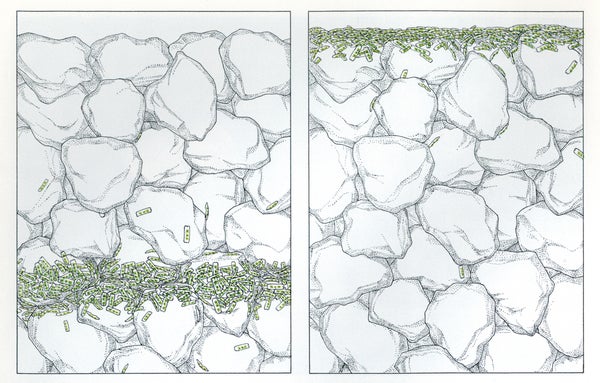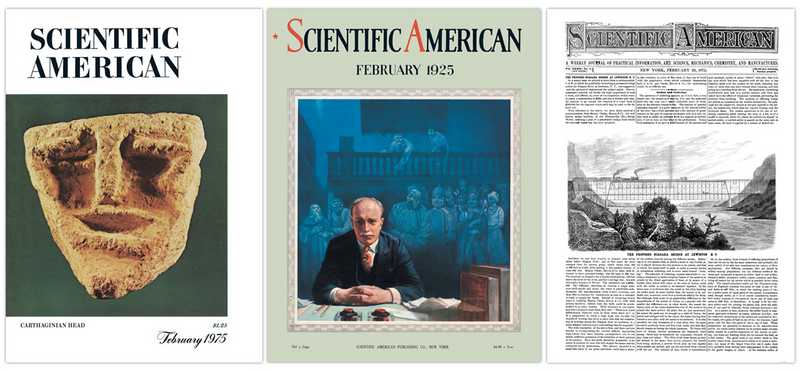January 21, 2025
3 min read
February 2025: Science History from 50, 100 and 150 Years Ago
Ant talk; vegetation on Mars

1975, Daily Micromigration: “The diatoms Hantzschia virgata reside about a millimeter below the surface of shoreline sand (left). During daytime low tides the organisms are propelled upward to the surface by mucus forced through pores at the end of their elongated, glassy cell wall (right). The diatoms remain in the sunlight, for photosynthesis, until moments before the sand is inundated by the returning tide.”
Scientific American Vol. 232, No. 2, February 1975
1975
Radical Revision of Continents and Poles
“Of the various hypotheses that preceded the modern theory of plate tectonics, one version propounded by Alfred Wegener early in the 20th century stands out. Wegener had access to only a small part of the information available today, yet his theory anticipated much that is now fundamental, including the movement of the continents and the wandering of the poles. When his view did replace the older model (in the 1960s), the change represented a radical revision of a well-established doctrine. In the interim, Wegener’s theory had at best been neglected, and it had often been scorned. At the nadir proponents of continental drift were dismissed contemptuously as cranks.”
On supporting science journalism
If you’re enjoying this article, consider supporting our award-winning journalism by subscribing. By purchasing a subscription you are helping to ensure the future of impactful stories about the discoveries and ideas shaping our world today.
1925
Spring Vegetation on Mars
“A series of photographs of Mars made by Slipher at the Lowell Observatory show in a very beautiful and convincing way how the dark regions grow larger and deeper in hue as the polar caps wane and the Martian spring advances. The dark markings on the opposite hemisphere, where autumn is changing to winter, are seen to fade. Slipher says, with reason, that the seasonal markings obey the law of change that we should expect of vegetation. Whether or not vegetation actually does cover much of the planet’s surface is harder to determine. If the chlorophyll of Martian vegetation is similar to that of terrestrial plants, it should reflect deep red light strongly, and the dark markings should show bright when photographed through a suitable screen. Nothing of this sort has been observed. But the test is not conclusive; many terrestrial plants do not show this peculiarity.”
1875
A Fine Hudson River Ice Harvest
“The Hudson River ice crop for 1875 has been harvested and is one of the largest and finest ever gathered. The blocks average 14 inches in thickness, and the total quantity secured is about two million tuns. This enormous supply will be chiefly consumed in the city of New York. It is brought down the Hudson River from the great ice houses, located at the water’s edge, in large barges towed by steam directly to the ice carts, and then conveyed to private dwellings. From a quarter of a tun to a half a tun a month is a common supply for a small family. The price is from $15 to $30 a tun.”
Nevada Streets Paved with Gold
“The denizens of Virginia City, Nev., boast that the very mud of their streets is rich in silver and gold. The principal streets were macadamized with refuse ore taken from the mines in early days. Since then, they have been steadily dusted with rich ore sifted down upon them from passing ore wagons, making a surface so precious that an ounce or two of mud proved on assay to contain, to the tun: silver, $7.54; gold, $2.32; total $9.86. ‘After this,’ exults the Enterprise of that richly paved city, ‘we may put on airs, even though our streets are villainously muddy occasionally, for the very mud on our boots contains both silver and gold.’”
Virginia City was a booming mining town in the mid-1870s, when population peaked at around 25,000. Population in 2020 was 787, according to the U.S. Census.
Do Ants Talk?
“Ants have an impressive ability to communicate. Information of common danger is quickly spread throughout colonies numbering many thousands, the news brought by perhaps one or two spies. Their mode of communication has been a mystery, the most plausible hypothesis being that it was by a sort of fencing with antennae. But according to a report of Professor Landois to the Natural History Society of Prussian Rhineland, ants are provided with a sounding apparatus resembling that of the sand wasp. Although its pitch is generally inaudible to human ears, its range of tone may be ample for a fully developed language. The next thing in order is an apparatus for making inaudible sounds audible; then some enterprising student may give us a comparative grammar of formic idioms.”
Scientists have long shown that ants communicate using chemicals called pheromones, which among other benefits helps them march single file in long lines. Yet in recent decades they have found that certain ant genera make noise, and even some ant pupae can communicate using sound.


